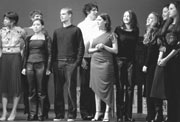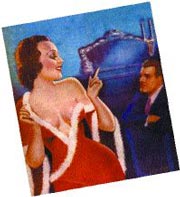ARMED WITH LITTLE more than a pair of scissors and personal style, aspiring designers dream about making their mark on the fashion world—but what qualifies as success? Those just starting out may believe that originality is the way to the top, though the ultimate measure of worth seems to come only with acclaim. Yet being “fashion forward” is not about trying to please, and perpetual invention in a grinding industry takes more than creativity and class—it takes confidence.
Finding your feet, then, is what fashion school is all about, and the Art Institute of Seattle’s annual fashion show allows youthful designers to do just that. This year’s production, Fashion Plates and Flying Saucers, held recently at the Moore Theatre, featured costumed aliens and amateur fashion models cavorting onstage in front of a packed audience of parents and friends—and a panel of judges—while the student designers waited to earn their due.
In the organized chaos backstage before the show, the designers seem eager to talk. Allen Wood steps aside from the fray for a moment, wearing a crumpled white button-down shirt and running his hands through his bright blue-and-green hair with the distracted air of Cure lead singer Robert Smith. “I start with a vision in my head,” he says. “By the time I’m done, I have an entire person built up. It gets pretty involved.” One of the few Seattle students with international design connections, he delightedly launches into a description of the outfit he’s planning for a Swedish singer, “an innovative pod dress that she’s going to wear to perform in a cave in Italy.”
Wearing a tight maroon corset and foil-wrapped dreadlocks, designer Katie Mineke is more business than bubbly. A recent graduate, she works as a design assistant at London Fog, and on weekends sews gothic corsets for Dark Industry, her fledgling e-business. Her clothes appear in the show segment titled “Gothic Clubwear.”
“I have three ensembles that revolve around the whole coming back of the corset,” she says. “The men’s corset would probably only be worn out to the club.”
Mineke is originally from a small town in Eastern Washington and likes “to go back and shock the folks.” Shrieking with a kind of self-incredulous nervous laughter, she adds, “When I moved to Seattle, something about the dark side intrigued me.”
In her dark satin dress and graceful updo, designer Sharon Seo is more elegant than her peers, and cites Gone With the Wind as her design inspiration. Seo’s garments in the “Formal Wear” segment are, she sighs dramatically, “avant-garde evening dresses—very romantic. I love satin, I love lace, I love organza. It’s a mix of Asian influence, European influence, American influence.” Originally from Korea, Seo feels like her current home is an ideal place to design. “I think Seattle has the most fashionable people in the world,” she says. “Go to Broadway [on Capitol Hill], and everyone is worrying about themselves—they want to make a fashion statement. In New York or L.A., people are followers.”
On the flip side of her breathy enthusiasm, Seo admits to feeling nervous about the show. “My parents have never seen my work,” she says. Has she waited long for everything to build to this? “Yes,” she says, “all my life.”
Robyn Laxamana is not as romantic. “They’re just clothes, honestly,” she says, her casual attitude belying her camera-ready look. Wearing a backless beige top with a floppy tie at the neck and a pleated brown skirt—an effective cross between librarian and sexpot—Laxamana is more effortlessly fashionable than most of the models. She boasts about making her cool outfit for $5 and claims that her dreams are small. “I don’t want to take over the world with my clothes; I don’t want to be a brand name,” she says. “I don’t want my clothes to be a trend. I like to make stuff that is a little more timeless, classic but right up on the edge.” Asked if her miniskirts and chunky belts are inspired by a particular era, she says she creates clothes based on her personal preferences: “I just like pleated, flared skirts. I like miniskirts. I don’t say, ‘Oh, corsets are in, so I’m going to do them.'”
There is not an original idea in the world, as a famous writer once said. But in the realm of fashion, as with the other arts, creators prefer to view their own vision as unique—and, ultimately, what defines original, anyway? Gothic clubwear designer Mineke says fashion is about “seeing what people are doing, and then putting your own little spin on it. Basically, it’s everyone just knocking off everyone else and making it better.”
According to the judges, Robyn Laxamana’s spin on fashion shows the right kind of promise—at the end of the evening, she stands onstage clutching her Fashion Forward design award to her chest, while the applause fills up the space around her.








